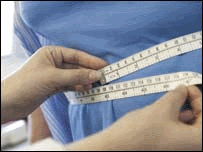|
Baby Boomers are Impacted by Obesity, High Blood Pressure Obesity raises the risk of heart disease, diabetes, arthritis and some cancers. Being An estimated two-thirds of Americans adults are overweight or obese, according to the government's annual report to the President and Congress on the health of all Americans on 2005: "Half of Americans aged 55-64 have high blood pressure - a major risk factor for heart disease and stroke - and two in five are obese" "Controlling high blood pressure and obesity is crucial for health, and particularly for baby boomers as they grow older," said HHS Secretary Mike Leavitt. "It's time to act against both conditions so more Americans can live longer, healthier lives." The report prepared by the Centers for Disease Control and Prevention's (CDC) National Center for Health Statistics from data gathered by state, federal health agencies and through ongoing national surveys, features an in-depth look at the 55-64 age group, which includes the oldest of the baby boomers. In 2011, the oldest of the boomers will be eligible for Medicare, and by 2014, the ranks of Americans ages 55-64 will swell to 40 million, up from 29 million in 2004. While many adults in their late 50s and early 60s enjoy good health, others are dealing with chronic and debilitating diseases and lack of health insurance. The report finds that minorities - primarily blacks and Hispanics - are more likely to fall into those categories. The report also notes that 11 percent of Americans ages 55-64 lack health insurance-compared to the national average of Americans under age 65 without health insurance (16.5 percent). Eighty-three percent of married adults ages 55-64 had private health insurance, compared to 60 percent of widowed, separated, divorced or single adults in that age group. The report also outlines how the United States spent $1.7 trillion -15 percent of the gross domestic product - on health care in 2003. That works out to $5,671 for every man, woman and child. The report also outlines how the United States spent $1.7 trillion -15 percent of the gross domestic product - on health care in 2003. That works out to $5,671 for every man, woman and child. Other highlights: More than a quarter of all adults suffered lower back pain in the past three months. Fifteen percent dealt with severe headaches or migraines (more commonly a problem for women). Fifteen percent had neck pain. Life expectancy at birth in 2002 reached 75 for males and 80 for females. At age 65, life expectancy was almost 82 for men and 85 for women.Two-thirds of high school students exercised regularly but only one-third of adults were physically active in their leisure time. Dr. Julie Gerberding, CDC Director, urged 55-to-64-year-olds to take careful stock now of their health, including such vital measures as weight, cholesterol level, blood pressure, risk of heart attack and any signs of diabetes. "The late 50s and early 60s are a crucial time of life to focus on disease prevention. It's never too late to adopt a healthy lifestyle to enjoy a longer, healthier life," she said. Source: the Centers for Disease Control and Prevention's (CDC) From Health, United States, 2005 report To Many Ignore Symptoms of Mini Stroke Only 1 in 10 sought emergency treatment in British study. By Ed Edelson from the U.S. National Health Information Center Fewer than half of the people in a new study who felt the symptoms of a "mini-stroke" sought medical attention quickly, and just one in 10 went to an emergency room. |
|
Salud+HealthInfo is for information and educational purposes only. You should not rely on this information as a substitute for personal medical attention, diagnosis or hands-on treatment. If you are concerned abut your health or that of a child, please consult your family's physician or health provider immediately and do not try to diagnose yourself. Salud+Health Info is published and distributed free of charge by Info Option Network (ION) Publishing Company. Copyright © 2001-2006 Info Option Network |
|
Only 1 in 10 sought emergency treatment in British study. |
To Many Ignore Symptoms of Mini Stroke
By Ed Edelson from the U.S. National Health Information Center
Fewer than half of the people in a new study who felt the symptoms of a "mini-stroke" sought medical attention quickly, and just one in 10 went to an emergency room.
"These figures are a cause for concern," said lead researcher Dr. Matthew F. Giles, a research fellow in clinical neurology at the University of Oxford, England. Continue
Heavy computer use could be linked to glaucoma
Glaucoma is caused by increased fluid pressure within the eye compressing the nerves at the back, which can lead to blindness if not treated. Glaucoma is the most important cause of irreversible blindness worldwide, affecting more than 500,000 people in the UK alone. More
 info
info pneumonia vaccine. The influenza season typically occurs between November and May. The flu vaccine is recommended for people age 60 and older, and younger people with chronic medical conditions. Click
pneumonia vaccine. The influenza season typically occurs between November and May. The flu vaccine is recommended for people age 60 and older, and younger people with chronic medical conditions. Click  overweight increases blood pressure and cholesterol levels, which in turn could lead to heart disease.
overweight increases blood pressure and cholesterol levels, which in turn could lead to heart disease.